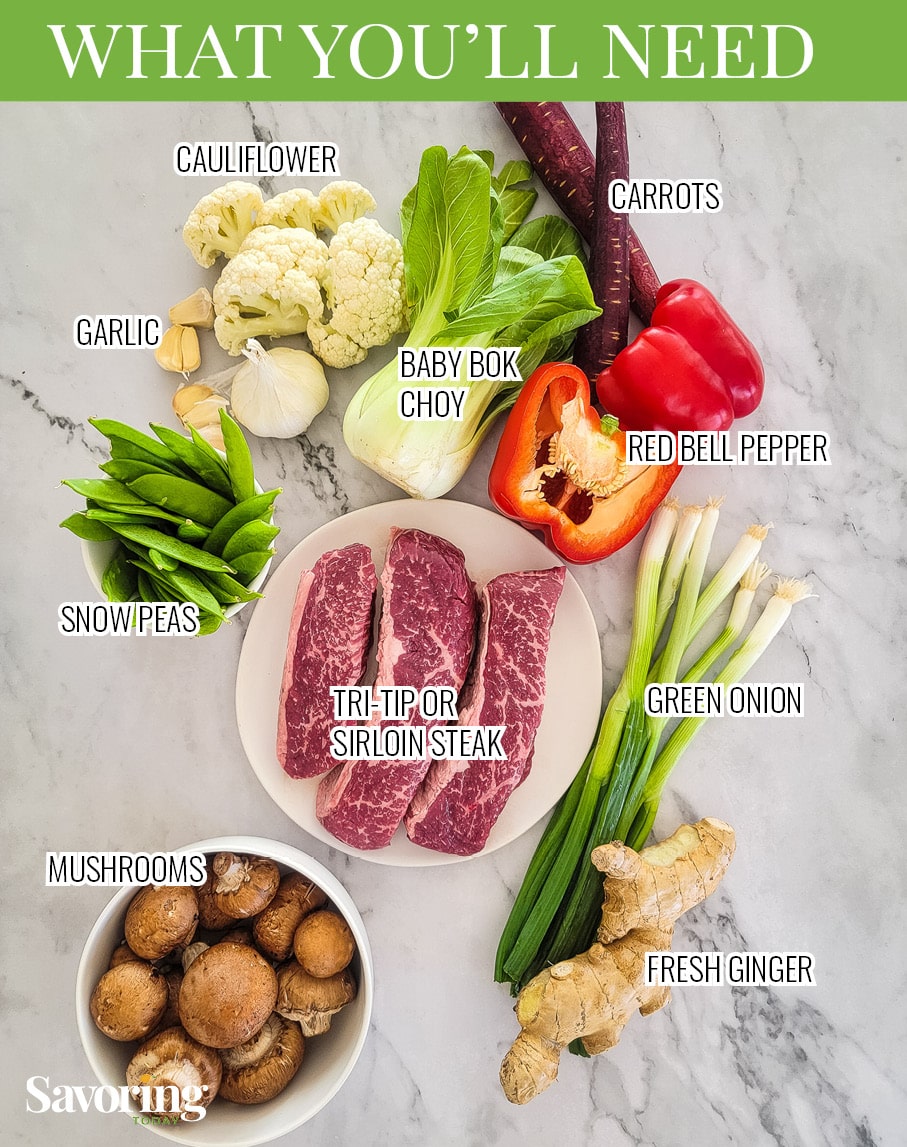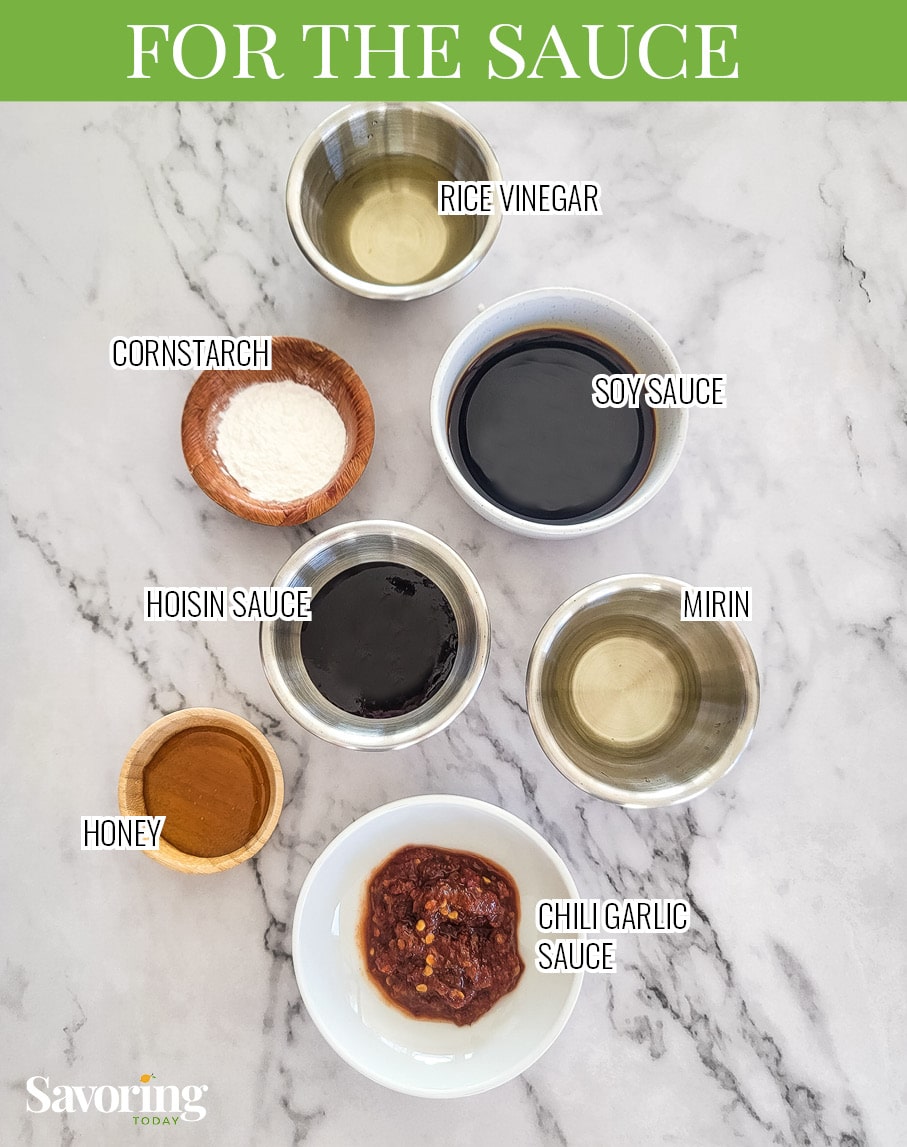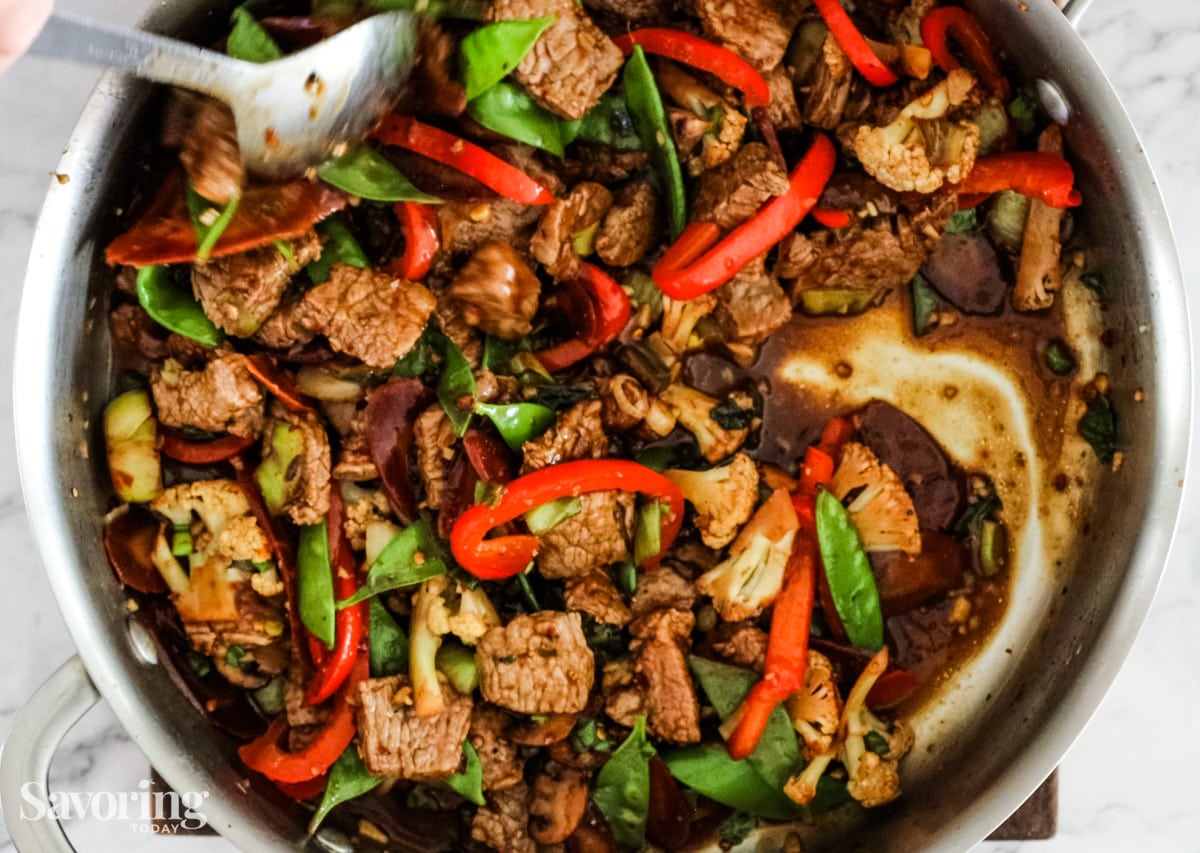Mongolian Beef and Vegetable Stir-Fry is a quick dish with tender bites of tri-tip and fresh vegetables with a savory, spicy brown sauce.
Love Mongolian Beef, but want to skip take-out and cook more at home? Yeah, us too! Check out how we make this super-tasty dish a complete meal on a busy weeknight.

Inspired by a local restaurant favorite, our take on Mongolian Beef is a quick, no-fuss recipe for tender bites of tri-tip beef and fresh vegetables with a savory, spicy brown sauce.
Contrary to its implied origins, the Mongolian Beef you know and love hearkens from the joined efforts of Taiwanese and Chinese cuisine. Traditional Mongolian cuisine involves a fair amount of yak milk and dried meats that suit a more nomadic and pastoral lifestyle. I can’t imagine you’ll find yak milk at your average grocery store.

Our take on this beef stir-fry dish comes from a place of inspired fusion without any claim of authenticity. We love authentic, restaurant-style Mongolian Beef but wanted more vegetables to soak up that tasty sauce and keep it healthy!
The stir-fry method is so quick and easy; there’s a reason it’s been around for ages. We love the versatility of mixing a favorite protein, vegetables, and sauce in a piping hot skillet with fresh garlic, ginger, and scallions.
And this Mongolian beef sauce tastes amazing on beef, chicken, pork, and mushrooms—seriously, it’s got an amazing flavor and is so versatile!
Protein focused? You got it. Vegetarian? Easy. Gluten-free? No problem. Low carb? We can do that. All doused in a delicious homemade sauce you’ll love.

Why we use Tri-Tip for Mongolian Beef
Typically Mongolian Beef recipes call for flank or skirt steak, and the meat is “velveted.” Taking time to tenderize the beef was a step we wanted to skip, so we used tri-tip steak with quality marbling and texture, requiring less help to become tender in the cooking process.
Tri-tip steaks or roast work for this recipe. If you end up with a tri-tip roast, simply cut the roast into steaks before slicing it for the stir-fry.
Depending on where you live, the name for Tri-Tip can vary, so it’s best to ask your butcher if you can’t find it. Otherwise, it may be packaged under one of these names:
- Tri-tip (steak or roast)
- The California cut
- Newport steak
- Triangle cut
- Bottom sirloin tip
- Bottom sirloin primal cut
- Bottom sirloin butt
- Santa Maria cut
Tri-tip is our go-to for Steak Chili, Stroganoff, and Skillet Beef Fajitas, too, because it is a tender cut with a big beef flavor but less expensive than other cuts of steak. For more details about tri-tip roasts and steaks and how to select the best cut, check out our Grilled Tri-tip Roast Recipe.
TIP: It is important to cut the pieces of tri-tip against the grain and into ¼-inch thick bite-size strips (not chunks).
What is velveting, and how do I do it?
Ahh, velveting. This process is foundational in Chinese cooking, and it has three major uses: It lends to even browning of the meat, locks in moisture, and creates a more available surface for sauce to cling to.
It also gives proteins a soft, tender, “velvety” texture. A slurry of corn starch or a simple application of baking soda help to tenderize especially fibrous proteins by making them more alkaline and interrupting their bonding at a molecular level.
So if you can’t find a tri-tip at the market and end up with a tougher cut of beef, try this velveting process.
Step-by-Step Basic Velveting for Beef:
- Slice meat against the grain into thin strips and pat dry with a paper towel.
- Sprinkle 1 1/2 teaspoon baking soda over the sliced beef (per pound)
- Mix the baking soda and beef with your fingers so it’s evenly coated
- Marinade your protein in this mixture for 30 minutes in the refrigerator.
- Rinse the baking soda off the beef and dry any excess water by blotting it with a paper towel.
The scientific breakdown has occurred; you can proceed with the Mongolian Beef recipe as written.

How to make Mongolian Beef Sauce
We’re not claiming authentic recipe status on this one. The hoisin and chili garlic sauce anchor the savory-spicy appeal of this dish, while the mirin and honey soften the edges with a hint of sweetness.
The how-to is pretty simple—whisk the sauce ingredients in a bowl and pour it over any combination of meat and vegetables you prefer in a hot skillet.
Does the sauce have to be spicy?
The chili garlic sauce is what adds a nice kick to this dish. If you do not want any heat, do not add the chili garlic sauce or only use a small portion and taste to see how you like it.

Recipe Step by Step
- Mix the sauce ingredients in a bowl until well combined and set aside.
- Stir-fry the vegetables with oil, salt, and pepper until lightly browned in spots, 8-10 minutes.
- Stir-fry the beef, ginger, garlic, and onions until browned, yet not cooked through; about 5 minutes.
- Stir in the vegetables and sauce mixture into the skillet with the beef, and cook for about 3 minutes, until the sauce thickens.
Recipe Variations
- Make it gluten-free by substituting Tamari for regular soy sauce, and check labels for gluten-free hoisin and chili garlic sauce.
- Substitute for store-bought chili garlic sauce: check out this homemade chili garlic sauce recipe
- Substitute for mirin: dry sherry or sweet marsala wine
- Substitute for hoisin sauce: teriyaki, but omit the honey in the recipe or make your own with this Hoisin Sauce Recipe
What should I serve with Mongolian Beef?
A scoop of steamed rice or lo mein noodles is a great carbohydrate addition to this meal. Cook rice or noodles separately and arrange the beef and vegetables next to them or toss noodles right in the skillet with the beef, veggies, and sauce.

Mongolian Beef and Vegetable Stir-Fry
Ingredients
FOR THE SAUCE:
- 3 tablespoons soy sauce or Tamari for gluten-free
- 2 teaspoons cornstarch
- 1 1/2 tablespoons hoisin sauce
- 1 1/2 tablespoons Mirin
- 1 1/2 tablespoons chili garlic sauce
- 1 1/2 teaspoons rice vinegar
- 1 tablespoon honey
FOR THE VEGETABLES:
- 2 tablespoons avocado oil
- 5 cups vegetables (any combination of carrots, bok choy, cauliflower, bell peppers, snow peas mushrooms etc.) — sliced thinly into bite-size pieces
- 1/2 teaspoon sea salt
- 1/2 teaspoon freshly ground black pepper
FOR THE BEEF:
- 2 tablespoons avocado oil
- 1 1/4 pounds tri-tip steak — (or sirloin) thinly sliced across the grain
- 2 tablespoons fresh ginger
- 1 tablespoon minced garlic
- 1/2 cup green onions coarsely chopped
Instructions
FOR THE SAUCE:
- Mix the sauce ingredients in a bowl until well combined and set aside.3 tablespoons soy sauce, 2 teaspoons cornstarch, 1 1/2 tablespoons hoisin sauce, 1 1/2 tablespoons Mirin, 1 1/2 tablespoons chili garlic sauce, 1 1/2 teaspoons rice vinegar, 1 tablespoon honey, 2 tablespoons avocado oil
FOR THE VEGETABLES:
- Heat oil in a large skillet over med-high heat. Add vegetables, season with salt and pepper, and stir-fry until lightly browned in spots, 8-10 minutes. Transfer to a platter and set aside.5 cups vegetables, 1/2 teaspoon sea salt, 1/2 teaspoon freshly ground black pepper, 2 tablespoons avocado oil
FOR THE BEEF:
- Heat oil in the same skillet used for the vegetable. Add the beef, ginger, garlic, and onions. Cook over med-high heat until browned, yet not cooked through, about 5 minutes.1 1/4 pounds tri-tip steak –, 2 tablespoons fresh ginger, 1 tablespoon minced garlic, 1/2 cup green onions
- Reduce heat to medium-low, add the vegetables and sauce mixture to the skillet with the beef, and cook bout 3 mintues, while stirring until sauce thickens. Serve over rice or cauliflower rice.
Video Displays Here or In Post
Notes
-
- Make it gluten-free by substituting Tamari for regular soy sauce, and check labels for gluten-free hoisin and chili garlic sauce.
-
- Substitute for store-bought chili garlic sauce: check out this homemade chili garlic sauce recipe
-
- Substitute for mirin: dry sherry or sweet marsala wine
-
- Substitute for hoisin sauce: teriyaki, but omit the honey in the recipe or make your own with this Hoisin Sauce Recipe


Pergola Alu says
Great website, thanks for the great recipes… I’ll use them again in the future 😉 THANK YOU !!! Greetings from Germany
Karen (Back Road Journal) says
This is my kind of a dinner, definitely full of flavor.